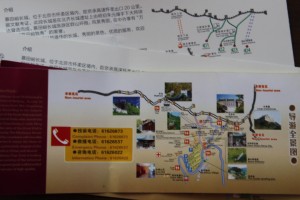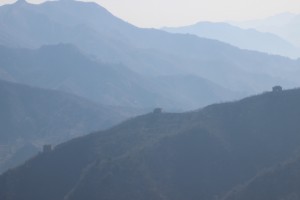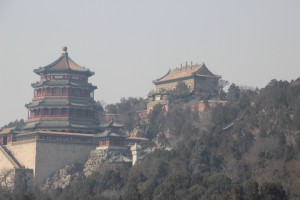Wednesday 2nd March
Today has been a very special one. We have visited one of the ‘Wonders of the World’ – The Great Wall of China. When the team were younger and before GPS and other satellites, astronauts went into space with hand held cameras. It was from space that this single continuous structure was the only man made object visible. On earth it is still a mind blowing achievement. To think that this 3 – 4 metres wide wall was built along the watershed for 690km is astonishing. The eastern end of the wall is at Shanhaiguain on the Bohai Sea and continues to Jiayuguan on the edge of the Gobi Desert in the west of China. It is thought that construction began in 453BC and continued through various dynasties until 220AD. The sections of the Great Wall that one can visit to the north of Beijing were reconstructed by the Ming dynasty between 1368 and 1644 in an effort to defend attack by the Mongols and others from the north.
The vary scenic section of the wall we visited was at Mutianyu. This section has been tastefully developed to accommodate lots of visitors. Away from the Wall, so as not to spoil the heritage, are the car parks, ticket offices, tourist shops and even a Burger King. A shuttle bus takes one to the cable car which enables one to access watchtower 14. There is continuing work here and new sections of the wall have been reopened from towers 21 to 23. None of this exploration is easy as from the shuttle bus drop off point it is a steep hike to the cable car and even steeper to get onto the wall. The builders must have had longer legs than the team as the steps and the thinner air certainly present a challenge!
Returning to the city we called in at the Summer Palace. This is a sprawling landscaped park which was the Imperial retreat in summer from the stifling confines of the Forbidden City and was the favoured haunt of the Empress Cixi. She is remembered as one of China’s most powerful women. She blocked state reforms and lent support to the Boxer Rebellion in 1900. Unwittingly she paved the way for the end of the Imperial era. The great lake is crossed by a 17 arch bridge built in the 18th century and is dominated by the Tower of the Fragrance of the Buddha. Cixi had the palace rebuilt twice. Once in 1860 after being demolished by the French and English troops and again in 1902 after the Boxer Rebellion.
Today the temperature reached around 16C but one could still feel the cooling breeze coming off the lake. It was time to return and fight the traffic in this sprawling city.
The Boxer Rebellion: 1900
Western powers were frustrated by China’s reluctance to open up to foreign trade. This put the Imperial court under pressure and led them into a war to protect their trade in opium. In 1900, supported by Empress Cixi, a band of rebels from the north of China known as the Boxers attacked parts of Beijing and it took a joint army of several nations to end the siege.
















